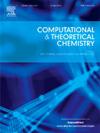Investigation of electronic and nonlinear optical properties of two-unit BODIPY systems linked by π-bridges using advanced Python-based analysis tools
IF 3
3区 化学
Q3 CHEMISTRY, PHYSICAL
引用次数: 0
Abstract
This study explores the electronic and second-order nonlinear optical (NLO) properties of cyclic and linear BODIPY-based chromophores, aiming to identify structural features that enhance hyperpolarizability (β). Using DFT and TD-DFT, alongside a custom Python tool (K.Z.py) for data visualization and analysis, we evaluated charge-transfer pathways, electronic transitions, and NLO responses at wavelengths of 1064 nm and 1907 nm. Our results show that linear configurations with thiophene-based π-bridges (notably L5 and L6) exhibit significantly higher hyperpolarizabilities, up to 2.50 × 105 a.u., compared to cyclic analogues, due to improved planarity and conjugation. DOS and PDOS analyses revealed how BODIPY cores and π-bridges contribute to the electronic structure and charge delocalization that drive NLO behavior. Unit Sphere Representation (USR) and harmonic light intensity analyses further confirmed dominant octupolar responses in these molecules. These findings provide valuable insights for the rational design of high-performance NLO materials for optoelectronic applications.

利用先进的python分析工具研究π桥连接的双单元BODIPY系统的电子和非线性光学性质
本研究探讨了基于环状和线性bodipi的发色团的电子和二阶非线性光学(NLO)性质,旨在确定增强超极化率(β)的结构特征。利用DFT和TD-DFT,以及定制的Python工具(K.Z.py)进行数据可视化和分析,我们评估了1064 nm和1907 nm波长下的电荷转移途径、电子跃迁和NLO响应。我们的研究结果表明,与环状类似物相比,具有噻吩基π桥的线性构型(特别是L5和L6)由于改善了平面性和共轭性,具有更高的超极化率,高达2.50 × 105 a.u。DOS和PDOS分析揭示了BODIPY核和π桥如何促进驱动NLO行为的电子结构和电荷离域。单位球表征(USR)和调和光强分析进一步证实了这些分子的显性八极响应。这些发现为合理设计用于光电应用的高性能NLO材料提供了有价值的见解。
本文章由计算机程序翻译,如有差异,请以英文原文为准。
求助全文
约1分钟内获得全文
求助全文
来源期刊

Computational and Theoretical Chemistry
CHEMISTRY, PHYSICAL-
CiteScore
4.20
自引率
10.70%
发文量
331
审稿时长
31 days
期刊介绍:
Computational and Theoretical Chemistry publishes high quality, original reports of significance in computational and theoretical chemistry including those that deal with problems of structure, properties, energetics, weak interactions, reaction mechanisms, catalysis, and reaction rates involving atoms, molecules, clusters, surfaces, and bulk matter.
 求助内容:
求助内容: 应助结果提醒方式:
应助结果提醒方式:


